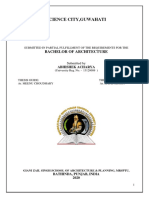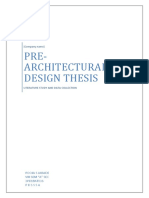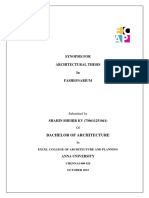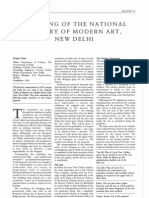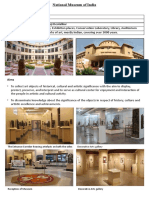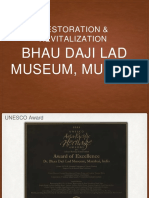Rakesh Joshi - Thesis Synopsis (NEW)
Rakesh Joshi - Thesis Synopsis (NEW)
Uploaded by
Bhaskar NamanCopyright:
Available Formats
Rakesh Joshi - Thesis Synopsis (NEW)
Rakesh Joshi - Thesis Synopsis (NEW)
Uploaded by
Bhaskar NamanOriginal Title
Copyright
Available Formats
Share this document
Did you find this document useful?
Is this content inappropriate?
Copyright:
Available Formats
Rakesh Joshi - Thesis Synopsis (NEW)
Rakesh Joshi - Thesis Synopsis (NEW)
Uploaded by
Bhaskar NamanCopyright:
Available Formats
Architectural
Thesis
Synopsis
Submitted To:- Submitted By:-
Rakesh Joshi
2MB16AT011
M.S.I.A.A.,
Vijayapura
NATIONAL MUSEUM OF ARCHITECTURE, NAVI MUMBAI
1. INTRODUCTION:
A museum is an institution that cares for (conserves) a collection of artifacts and other objects of artistic,
cultural, historical, or scientific importance. Many public museums make these items available for public viewing through
exhibits that may be permanent or temporary. The largest museums are located in major cities throughout the world, while
thousands of local museums exist in smaller cities, towns, and rural areas. Museums have varying aims, ranging from
serving researchers and specialists to serving the general public. The goal of serving researchers is increasingly shifting to
serving the general public.
2. HISTORY OF MUSEUMS:
Early museums began as the private collections of wealthy individuals, families or institutions of art and rare or
curious natural objects and artifacts. These were often displayed in so-called wonder rooms or cabinets of curiosities. One
of the oldest museums known is Ennigaldi-Nanna's museum, built by Princess Ennigaldi at the end of the
Neo-Babylonian Empire. The site dates from c. 530 BCE, and contained artifacts from earlier Mesopotamian civilizations.
Notably, a clay drum label—written in three languages—was found at the site, referencing the history and discovery of a
museum item.
While some of the oldest public museums in the world opened in Italy during the Renaissance, the majority of these
significant museums in the world opened during the 18th century:
3. The Capitoline Museums, the oldest public collection of art in the world, began in 1471 when Pope Sixtus IV donated
a group of important ancient sculptures to the people of Rome.
4. The Vatican Museums, the second oldest museum in the world, traces its origins to the public displayed sculptural
collection begun in 1506 by Pope Julius II
THESIS SYNOPSIS 1.MUSEUM 2.HOSPITAL 3.INTEGRATED RAKESH JOSHI – 9TH SEM
3. HISTORY OF ‘MUSEUM OF ARCHITECTURE’
It is a museum dedicated to educating visitors about architecture in general or with a focus on a specific
architectural style. Architecture museums may also educate visitors on the traditional history of architecture or art, which
can provide useful context for many architecture exhibits. They are often chartered with the principle of advancing public
education on how design can positively impact the human environment.[1] Some architecture museums, such as the
Chicago Athenaeum also educate visitors in a variety of other related fields, such as urban design, landscape design,
interior design, and historic preservation.
The world's first museum dedicated solely to the discipline of architecture was Shchusev Museum of Architecture
in Moscow in 1934, followed by the Museum of Finnish Architecture in 1956.[2][3][4] Other museums are not entirely
dedicated to architecture but do contain architecture sections (such as Museums of Metz in Metz, France), architecture
halls (such as Chicago Athenaeum, in Chicago, Illinois, US), or architecture galleries (such as
University of South Australia's Architecture Museum in Mount Gambier, South Australia).
The International Confederation of Architectural Museums is an international organization for architecture museums.
Members consist of museums, centers, collections and other institutions that offer permanent exhibitions or dedicated
galleries on architecture.
Some examples of National Museum Of Architecture;
German Architecture Museum, Archizoom (EPFL), Lausanne, Museo Nacional de Arquitectura,
Frankfurt, Germany Switzerland Mexico City, Mexico
THESIS SYNOPSIS 1.MUSEUM 2.HOSPITAL 3.INTEGRATED RAKESH JOSHI – 9TH SEM
4. MOTIVATION:
The idea of this thesis is to explore and find out what an architectural museum should aim to do. The understanding
of architecture varies between architects and the public. Every person is directly or indirectly affected by any piece of
architecture, just that majority of them don’t realize what is it about architecture that’s affecting them and how. They
appreciate/criticize architecture consciously/sub-consciously at times without understanding why it is the way it is. This
difference in understanding between the architect and his/her subject (any person getting affected by architecture) needs to
be brought to the same level by providing a platform that brings them together. This museum will become a center for
knowledge for everyone visiting it.
It will become an icon that people want to see when they visit the city of Delhi. It will become an inclusive public
place for people from all backgrounds to gather and talk about architecture. It will become a place of education for
aspiring architects to do their research and understand architecture. Most importantly, it will become a place that is
important to city without disturbing the city fabric. It should stand out not in terms of its form, but in terms of the spatial
experience. The architectural expression will be such that it reflects the past, present and the future of architecture.
5. OBJECTIVES AND SCOPE AND LIMITATIONS:
The museum is meant to house information about other buildings so that the visitors understand and learn why they
appreciate or they don’t when visiting a piece of architecture. It might be known as the guardian of heritage. It might be
known as a center of knowledge for those who wish to know about architecture. It might be a platform for people to
connect to each other through the exhibits and spaces. Whatever this museum is identified as will be a reflection of what it
aims to do.
This thesis aims to connect the society to architecture on a level that bridges the gap between the understanding of the
architecture between the architects and their victims (referred to anyone getting affected by any piece of architecture).
THESIS SYNOPSIS 1.MUSEUM 2.HOSPITAL 3.INTEGRATED RAKESH JOSHI – 9TH SEM
6. DESCRIPTION OF THE THESIS PROJECT:
The museum will exhibit the architecture marvels of the past, accomplishments of the present and the vision for the
future. The experience will involve weaving of all the three phases of time, a time-line to dive into. This experience of a
time-line will be translated into architecture. Therefore, the museum will be dedicated to both historic and contemporary
works, it will be journey from certainty to uncertainty which will further get translated into the architecture of exhibition
spaces, site planning and the building form.
MAJOR FUNCTIONS:
7. LIBRARY: Library provides services to the public and contain large number of books or volumes related to all
aspects of architecture including biographical information about renowned architects.
2. CONVENTION CENTER: Auditorium, Multipurpose hall and exhibition galleries are largely public function,
people- intensive components. These spaces allow events like seminars, lectures, film-screenings, launches of new
proposals, etc.
3. MUSEUM: Museum is an institution that cares for a collection of artefacts and other objects related to subject which
are available for public viewing through exhibition that may be permanent or temporary. The museum will house
various galleries showcasing the historic works of architecture to the traditional-vernacular to the contemporary
architecture. It will house drawings, models, photographs and films showing depicting design as well as the
construction process.
4. RESEARCH CENTER: It is consisting of R&D labs, innovation centers, discussion rooms, workshops, lecture rooms
all programmatic element associated with the activities involve in the pursuit and dissimulation of knowledge.
THESIS SYNOPSIS 1.MUSEUM 2.HOSPITAL 3.INTEGRATED RAKESH JOSHI – 9TH SEM
7. AREAS OF RESEARCH:
1. MEDIUM: In a museum of architecture, it is important to understand the medium through which architecture will be
exhibited. It may be models, drawings, photographs, digital media and also virtual reality. Therefore, it will be required to
be specified what is needed in this case.
2. PROGRAMMATIC CONTENT: It will also be necessary to study the programmatic content in order to evolve an area
program. The study shall also focus on the sub-divisions and inter-relationships of each component.
3. REFLECTION OF TODAY: The museum should reflect the present, therefore there will be a need to study how are the
buildings such as museums and research centers which are meant for public/ semi-public use being designed today, in
addition to the study of the ones which have been significant since a number of years.
8. LIST OF CASE STUDIES
Museum of Socialism- The Bihar Museum,
1 Patna
2
Interpretation Center,
Lucknow - This is the first
- A unique approach Competition based
towards design in design on Bihar
museum heritage museum
- Incorporating both
outside and insides
as the elements of
museum spaces.
THESIS SYNOPSIS 1.MUSEUM 2.HOSPITAL 3.INTEGRATED RAKESH JOSHI – 9TH SEM
SEMI-INTEGRATED TOWNSHIP
1. INTRODUCTION
Integrated townships is a self-sustained development with all the basic modern amenities developed in an plot
area of more than 20 acres on outskirts adjoining to existing city having a number of developments that include
residential, commercial, retail, recreational, educational, as well as industrial areas in some cases. They should have a
proper balance of residential & commercial spaces along with well-developed modern infrastructure & recreational
amenities besides green and open spaces
Integrated Townships can be defined as "Housing schemes in public-private partnership to provide affordable
housing to various sections of the society in urban areas of the State". An integrated township is a self sustainable
township mainly initiated by private developers in order to provide, in advance, the amenities and facilities (residential,
commercial, recreational, public, etc.) required by a fully groomed Town ship.
2. HISTORY OF INTEGRATED TOWNSHIP:
The concept of townships started in the late ’90s to enable the outward expansion of major cities. Over a period of
time, rapid infrastructure development bridged the connectivity to far-flung peripheral regions via road, rail, and metro,
helping small and large townships to become part of emerging business districts and providing close proximity to the main
city areas. It offers a complete living experience to citizens, an all-in-one solution for their needs as well as an integrated
lifestyle with a self-contained ecosystem and the added advantage of walk-to-work. This helps in saving time, hassle-free
work commute, and greater leisure time for work-life balance. The demand for integrated townships would see an
unprecedented rise in the post-COVID world due to the ease of living they offer and bring essential living to the doorstep.
THESIS SYNOPSIS 1.MUSEUM 2.INTEGRATED TOWNSHIP RAKESH JOSHI – 9TH SEM
2. MOTIVATION
For a lot of metropolitan cities today which are facing chaotic situations due to various problems, few of them
like the growing population, migration of people from rural to urban areas, increasing housing demand inadequate
infrastructure of the city, etc. and much such problems-integrated township development is the need of the day.
Integrated townships are an important segment and certainly a good business proposition. They are the way to
go because they bring together all the elements that customer's demand which is "walk to work' lifestyle, shopping
complexes, facilities for leisure and entertainment. As the cities are expanding and traffic congestion becoming a common
hindrance, integrated townships promise a congestion-free living environment within them and help in decongesting the
city. They offer standard of living and ambience, which are much ahead of the times.
Today, owning a home in the city has become a lot more cumbersome and costly now, the only solution for
the ever-surging prices and increasing interest rates on home loans is to own a property in an integrated township coming
up in the outskirts of the city. These townships are being touted as the new paradigm of real estate development in India
that will help satisfy the growing affluence and aspirations of India's urban population. Though in a nascent stage, these
self-contained townships encompassing residential, retail and commercial infrastructure with in a single geographical
entity will soon spread across the country. An integrated township on the sub urban areas of a largely populated urban
metropolitan city is the new emerging
3. OBJECTIVES, SCOPE AND LIMITATIONS
1. To promote economic development.
2. To facilitate the creation of efficient equitable sustainable urban settlement.
3. To facilitate public private partnership in urban development.
4. To set an idea of ‘open living’, which cannot only be delivered through more spacious & better designed homes
with proper privacy, direct ventilation & Lighting, but can also be through meticulous planning of the
infrastructure, like extensive landscaping, Open area, play area for children’s gathering for senior citizen,
Separate cycling & Jogging track, internal road network, traffic flow planning and provision of pedestrian
walkways that encourages safe, pleasant and comfortable life style within the townships.
THESIS SYNOPSIS 1.MUSEUM 2.INTEGRATED TOWNSHIP RAKESH JOSHI – 9TH SEM
5. Dynamically zoned spaces which would encourage holistic living -promote lively surroundings The main spine
road should designed properly to segregate the vehicular traffic of Residential, Academic & Commercial zone
and give proper axis to all the cluster in the all the zone and Commercial & academic zone should be easily
accessible from all the cluster & Effective proper utilization of the OSR Space for landscape, With Green
Sustainability, effective usage of Rain water, recycled water & Recycling of garbage waste effectively
Residential zone can be planned and divided into number of cluster of building.
6. Each cluster building in the Integrated township should be designed with proper Common amenities like club
house, Swimming pool, Gymnasium, Indoor & Outdoor games, Children play area, Senior citizen recreation,
Landscape areas& Day care for children, Super market and other basic amenities
4. DESCRIPTION OF THESIS & MAJOR FUNCTION:
5. Residential: A quality housing solution which is affordable, and keeping in mind the livability and sociability
concepts.
6. School: A quality school with education up to at least 10th standard is set up within the township, reducing the
travelling time between home and school and in turn providing the children with more time for playing and studies.
7. Medicare: A good healthcare facility with at least 50-plus beds and an emergency care is set up within the township,
thereby facilitating the residents.
8. Recreation: Adequate space for basic sports such as football, cricket, tennis and badminton, fitness facilities including
a gymnasium and swimming pools are set up within the township to enhance social lifestyle.
9. Community center: A spacious, well-decorated community center with a club house and a function hall is set up
within the township. Infrastructure and services: An integrated township needs to be self-contained in most aspects,
essentially on basic infrastructure.
10. Road network: A well-planned road network both within the township and connecting to the nearest highway or main
road is built, thereby easing communication.
11. Water supply and management: A well-planned and sustainable water management system is built within the
township, providing round the clock water supply to residents as well as treating the waste water generated within the
township and recycling it. This also reduces dependence on municipal water supply.
THESIS SYNOPSIS 1.MUSEUM 2.INTEGRATED TOWNSHIP RAKESH JOSHI – 9TH SEM
5. Electricity supply and management: Although an integrated township depends on a public or private utility
supplier for basic power supply, it has adequate, if not abundant, back-up power for both homes and common
areas during temporary or scheduled power cuts or disruptions by the utility supplier.
6. Communication infrastructure: Good quality telecom services are also made available within the township and
nearby.
7. Garbage and waste management: Good garbage collection, aggregation, treatment and disposal system is a
must for a healthier and eco-friendly township.
8. Infrastructure maintenance: Proper and regular maintenance of roads, pathways, parks, electrical and plumbing
infrastructure, children play areas and common areas including community center is essential for a well
developed integrated township.
9. Security: Superior estate security and safety for all residents is a critical element of an integrated township.
10. Shopping and entertainment: An integrated township is incomplete without shopping centers and entertainment
areas.
11. Entertainment: Quality cinema or multiplex, popular games and kid entertainment facilities should be
established within the township.
12. Shopping: Well-stocked grocery stores as well as shopping centers including branded garment stores, electronic
goods should be established within the township.
13. Food courts: Good quality and hygienic food courts with ample menu options should be established within the
townships to cater to the taste buds of all types of residents.
14. Proximity to workplace: While the intent of an integrated township is always to have the workplace and the
residential dwelling in close proximity, in the current context of double-income families, it is practically
impossible to achieve this objective fully. However, we can establish adequate, well-equipped small office
space infrastructure and offer lower rentals to attract companies, banks and corporate houses and create ample
opportunities for residents.
With such types of infrastructure and services, integrated townships will undoubtedly develop the cities across India
in more equitable and uniform manner, solving the country's major urban problems such as bad roads, traffic congestions,
inadequate water and power supply and poor sanitation system.
THESIS SYNOPSIS 1.MUSEUM 2.INTEGRATED TOWNSHIP RAKESH JOSHI – 9TH SEM
4. AREAS OF RESEARCH:
1. Study of the concerned governing body’s bye-laws.
2. Housing Typologies
3. Road circulation patterns.
4. Town planning concepts and typologies.
5. Green Building Construction Techniques.
6. Energy conservation concepts.
7. Other complimentary services such as- Rain Water Harvesting, WTP & STP, Garbage Disposal Plants, Solar
Energy Plants, Security Measures, etc.
5. CONCLUSIONS:
The post-COVID world will witness a new normal trend of township living that offers an all-inclusive lifestyle that
features education centers, schools, pharmacy and hospitals, high-street retail and eateries, entertainment, and recreation
zones with safety and security that truly reflects ‘Ease of Living’.
Being safe under one’s own roof without missing out on leisure and a good standard of living is what integrated
township living is all about. Discerning homebuyers should definitely consider such living options that bring joyful
community living with like-minded people, enjoy the green ecosystem with nature trails, and the benefits of a one-stop
destination without compromising on the safety aspect. This is a true value proposition that township living can offer to
prospective home buyers with appreciated value assets in the long run.
THESIS SYNOPSIS 1.MUSEUM 2.INTEGRATED TOWNSHIP RAKESH JOSHI – 9TH SEM
6. CASE STUDY:
1 2
MAGARPATTA INTEGRATED TOWNSHIP AMONARA INTEGRATED TOWNSHIP
• Spread over 430 acres, Magarpatta City is an award - India’s 1st fully developed integrated township.
winning and internationally acclaimed model of - It was also the first Smart City of its kind in the
integrated development and self-sustainability. country
• A city within a city, Magarpatta City is home to a - Amanora has received over 300+ awards
commercial zone, residential neighborhoods, two • Best Affordable Housing’ at City level award
schools, a multi specialty hospital, a shopping mall, by CNBC Awaz (Metro Towers)
multiple restaurants, a gymkhana and a large 25 acre • ‘High Rise Architecture’ award in Asia Pacific
serene park called Aditi Garden. Awards, Singapore (Gateway Towers)
THESIS SYNOPSIS 1.MUSEUM 2.INTEGRATED TOWNSHIP RAKESH JOSHI – 9TH SEM
MULTI-SPECIALTY HOSPITAL, Bengaluru
1. INTRODUCTION:
A hospital is a healthcare that provides medical, surgical and nursing treatments to the sick or injured
specialized staff and equipment. Hospital is not just a care center, it is a place of cure as well as pleasant, cleanliness,
healthy and mind supporting environment. It provides happiness, peacefulness, calmness ambience. As we know “Health
is Wealth” - healthy mind lives in a healthy body and a healthy poor man is richer and happier than a healthy richest sick
man. To use the prosperity in efficient way we need a healthy body in this physical world, the human body is the most
peculiar and advanced machine developed by nature whose efficiency and energy level is unknown till now, one can not
measure the human mind and body in perfect way. There are hundreds of path to cure seek people few of them are
commonly used and few are rarely used. It is a sacred place, where most people were born and die. People are served and
taken care of here, when they are mentally or physically ill. It sets the foundation of a stable society. Hence, the concept of
hospital goes far beyond the conventional idea of a place for treatment of sick. The rapid and almost uncontrolled growth
of population has put the healthcare facilities under severe pressure, that are already in significant deficiency. According to
the WHO norm, India’s proportion of hospital beds to population is less than one-third of the set standards. Hence,
India needs to add more beds and hospitals, about two-thirds of which should come up in rural areas. Architecture affects
people. The architecture of hospitals contributes to the well being and recovery of patients. This bold proposition dates
back to 18th century and has been a recurring theme in the functional development of hospital architecture ever since.
THESIS SYNOPSIS 1.MUSEUM 2.INTEGRATED TOWNSHIP RAKESH JOSHI – 9TH SEM
2. HISTORY OF HOSPITALS:
The history of hospitals began in antiquity with hospitals in Greece, the Roman Empire and on the Indian
subcontinent as well, starting with precursors in the Ascelpian temples in ancient Greece and then the military hospitals in
ancient Rome. No civilian hospital existed until the Christian period. Towards the end of the 4th century, the "second
medical revolution" took place with the founding of the first Christian hospital in the eastern Byzantine Empire by
Basil of Caesarea, and within a few decades, such hospitals had become ubiquitous in Byzantine society. ] The hospital
would undergo development and progress throughout Byzantine, medieval European and Islamic societies from the 5th to
the 15th century. In the early modern era care and healing would transition into a secular affair.
In the Medieval period the term hospital encompassed hostels for travelers, dispensaries for poor relief, clinics and
surgeries for the injured, and homes for the blind, lame, elderly, and mentally ill. Monastic hospitals developed many
treatments, both therapeutic and spiritual.
In the 18th century, under the influence of the Age of Enlightenment, the modern hospital began to appear, serving
only medical needs and staffed with trained physicians and surgeons. The goal was to use modern methods to cure
patients. They provided more narrow medical services, and were founded by the secular authorities. A clearer distinction
emerged between medicine and poor relief. Within the hospitals, acute cases were increasingly treated alone, and separate
departments were set up for different categories of patient.
In the mid 19th century, hospitals and the medical profession became more professionalized, with a reorganization
of hospital management along more bureaucratic and administrative lines. By the late 19th century, the modern hospital
was beginning to take shape with a proliferation of a variety of public and private hospital systems. By the 1870s,
hospitals had more than tripled their original average intake of 3,000 patients.
In the U.S., the number of hospitals reached 4400 in 1910, when they provided 420,000 beds. [82] These were
operated by city, state and federal agencies, by churches, by stand-alone non-profits, and by for-profit enterprises.
Improvements in medicine, medical technology, major worldwide pandemics in 1918 and 2020, and management
and consolidation of hospitals were the primary influences on hospitals during the 20th and 21st century.
THESIS SYNOPSIS 1.MUSEUM 2.INTEGRATED TOWNSHIP RAKESH JOSHI – 9TH SEM
3. MOTIVATION
There are very few people who enjoy being at the hospital. By their very design, they are there for people when
they are having some of their worst moments. The fluorescent lights, beeping equipment, stark walls, and nauseating
smells are enough to make us on edge. As if a healthcare visit wasn’t stressful enough, now we also get overwhelmed by
the environment itself.
But your building’s interior and exterior design has the power to significantly improve a patient’s visit. There are
ways you can use it to reduce stress and promote relaxation, even if it’s just changes to the decorations in the
waiting room. The most efficient way to do this is by introducing a Biophilic design in healthcare. This concept connects
the industrial buildings with the natural environment.
“Biophilia refers to the hypothesis that humans have a tendency and desire to interact
with and be in nature.”
This might seem like a new idea, but it dates back to 1984. Edward O. Wilson first popularized biophilia as a human
need for continuously connecting to the natural world.
Even though this idea is almost 40 years old, it’s becoming more popular. This is due to the world’s increase in
urbanization as people experience a lack of nature in their everyday life. In the US alone, almost 83% of the population
lives in urban areas. This rate continues to steadily increase.
This nature-centric building concept doesn’t just improve aesthetics, though. It also benefits our health.
One interview found that 95% of people experienced improved mood after spending time outside. They went from
depressed and anxious to calm and balanced.
Stress has a major impact on the rate at which we heal. These problems that I mentioned aren’t conducive to
patient healing and instead cause more complications. But in biophilic environments, post-operative recovery time
decreased by 8.5% and pain medication decreased by 22%.
This biophilic design in healthcare not only boosts our mental well-being, but certain elements will also improve the
physical quality of a space. Introducing plants in your medical facility can improve air quality. They
absorb airborne pollutants and can remove harmful compounds in paint, carpets, and furniture. Plants also add water
vapor back into the air which helps when the air is dry. This is necessary since dryness can cause respiratory irritation and
illnesses.
THESIS SYNOPSIS 1.MUSEUM 2.INTEGRATED TOWNSHIP RAKESH JOSHI – 9TH SEM
3. OBJECTIVES, SCOPE AND LIMITATIONS:
• To provide access to the local people with the special care and facilities for their advanced diseases.
• To provide an healing environment in the hospital.
• To group all the disciplines of medicine in one building to provide a better and holistic service to the people.
• To provide a hospital with technology and proper infrastructure facilities.
• Patient oriented design strategy
• Understanding the complexity of Hospital Design – How departments are interlinked, equipments and machinery are
being used.
• Application of green ideas into hospital design.
• The objective of the design is to create a building that is user friendly, applies appropriate building methodologies in
keeping with the locally available materials.
• The main principle that is more important to remember in hospital planning is circulation. Because proper circulation
pattern is sometime essential in saving someone’s life.
• The traffic patterns for movements of physicians, hospital personnel, patients, visitors should be concentrated.
Moreover efficient transportation of food, linen, drugs and other supplies are handled carefully.
4. DESCRIPTION OF THESIS & MAJOR FUNCTION:
1. OUTPATIENT DEPARTMENT (OPD): An OPD provides primary as well as comprehensive healthcare for
patients who come for diagnosis, treatment or follow-up care. It is the first point of contact between hospital
and a patient. Importance of OPD is that it reduces the number of terminally ill patients traffic, as it helps in
early detection or timely care of various diseases.
2. ACCIDENTS AND EMERGENCY : Emergency medical services is an integral part of any hospital.
Emergency has been defined by the WHO as a condition determined by the patient or his/her relatives as
requiring urgent medical attention. Emergency department is considered as the “Front Door” of the hospital, as
it accounts for highest number of all hospital admissions. It screens the patient for the first aid, minor
operations, major operations or admission. It provides the first step of treatment in a trauma case or any
emergency.
THESIS SYNOPSIS 1.MUSEUM 2.INTEGRATED TOWNSHIP RAKESH JOSHI – 9TH SEM
4. DAY CARE SERVICES: It is a unit where treatment/operative procedures are provided in a way that patients can
return home in a day. The procedures may be diagnostic or minor surgical. It is also known as ambulatory service. It
might be a stand alone service or attached with the hospital.
5. INPATIENT DEPARTMENT: The inpatient department is the place where patients are admitted for longer duration or
may be even for a day care facility is not available in a hospital. It is a most important part of a hospital, as it is a
home away from home, the environment of this unit must be warm, flexible and should allow freedom of use of space
according to one’s need and suitability, while keeping healthy safety in mind
6. OPERATION THEATRE: It is specialized facility in a hospital where life saving or life improving procedures are
carried out on human body by invasive methods under strict sterile environment maintained mechanically to provide
for safe and infection free results.
7. INTENSIVE CARE UNITS: ICU is a dedicated facility to critically ill patients who require invasive life support, high
level of medical and nursing care and complex treatment. It is a unit equipped to treat critically sick patients promptly
and efficiently.
8. LABORATORIES: Modern medicine is becoming increasingly dependent on laboratory services for prevention,
diagnosis and control of disease. It conducts tests for the diagnosis, progress and responses to therapy.
9. CENTRAL STERILE SUPPLY DEPARTMENT: A CSSD is hospital support service, which is entrusted with
processing and issue of supplies including sterile instruments and equipment used in various departments of a
hospital.
10. MORTUARY: The main objective of this facility is to provide for a suitable place for temporary hold of a dead body.
THESIS SYNOPSIS 1.MUSEUM 2.INTEGRATED TOWNSHIP RAKESH JOSHI – 9TH SEM
5. AREAS OF RESEARCH
Understanding the functioning of the various departments of hospital and their co-relation with each other.
• Biophilic Design Principles and Techniques
• Circulation pattern
• Typologies in hospital design.
• Understanding the local culture and its influence in hospital design.
• Understanding the components of healing environment which will enhance the healing character of the hospital.
• Sustainable principles for energy conservation
• Principles of Landscape Design
6. LIST OF CASE STUDIES
THESIS SYNOPSIS 1.MUSEUM 2.INTEGRATED TOWNSHIP RAKESH JOSHI – 9TH SEM
THESIS SYNOPSIS 1.MUSEUM 2.INTEGRATED TOWNSHIP RAKESH JOSHI – 9TH SEM
You might also like
- A Comparative Analysis Between LIC and Private Insurance CompaniesDocument65 pagesA Comparative Analysis Between LIC and Private Insurance CompaniesShashank Tripathi87% (129)
- Improving Interchanges: Toward Better Multimodal Railway Hubs in the People's Republic of ChinaFrom EverandImproving Interchanges: Toward Better Multimodal Railway Hubs in the People's Republic of ChinaNo ratings yet
- Art Museum & Library Ota, Japan: Akihisa HirataDocument12 pagesArt Museum & Library Ota, Japan: Akihisa HirataNuthana DNo ratings yet
- Museum of Bihar in PatnaDocument3 pagesMuseum of Bihar in PatnaAbhishekGaurNo ratings yet
- Thesis Synopsis ArtsnDesignDocument2 pagesThesis Synopsis ArtsnDesignPooja Gnanendra100% (1)
- SYNOPSIS Science City July FinalDocument4 pagesSYNOPSIS Science City July FinalSahil PuniaNo ratings yet
- Science CityDocument11 pagesScience CityAbhishek Acharya100% (1)
- Museum ArchitectureDocument5 pagesMuseum ArchitectureAzhar0% (1)
- BrokersDocument47 pagesBrokersManjunath ShettigarNo ratings yet
- Museum Synopsis FinalDocument17 pagesMuseum Synopsis FinalShivam AroraNo ratings yet
- National Museum of ArchitectureDocument4 pagesNational Museum of ArchitectureSupria JanvejaNo ratings yet
- Architectural Museum With Art GalleryDocument7 pagesArchitectural Museum With Art GallerytanujaNo ratings yet
- Synopsis: Museum Architecture: by Gopika Thaplyal 4 Year B.ArchDocument5 pagesSynopsis: Museum Architecture: by Gopika Thaplyal 4 Year B.ArchPrafull Raut100% (1)
- Fashion Museum Literature Study-1Document14 pagesFashion Museum Literature Study-1SairamAppariNo ratings yet
- Pur073bae012kedarchhetri P.M.O.A Provincial Museum of Arts at Itahari 1Document208 pagesPur073bae012kedarchhetri P.M.O.A Provincial Museum of Arts at Itahari 1ZackNo ratings yet
- Architectural Thesis Project - Experiential Museum of AnthropoceneDocument12 pagesArchitectural Thesis Project - Experiential Museum of AnthropoceneanashwaraNo ratings yet
- National War Museum Design BriefDocument5 pagesNational War Museum Design BriefPraveen KumarNo ratings yet
- Bhagwan Mahaveer School of Architecture Design Problem - 3: Bollywood Art MuseumDocument11 pagesBhagwan Mahaveer School of Architecture Design Problem - 3: Bollywood Art MuseumAjay Jain100% (1)
- Thesis Proposal MUSEUM FOR FASHION EXHIBITDocument9 pagesThesis Proposal MUSEUM FOR FASHION EXHIBITPrashna Shrestha100% (1)
- Design Brief Museum ARC065Document3 pagesDesign Brief Museum ARC065Pratik Samal100% (1)
- Vasant KunjDocument3 pagesVasant Kunjyaman raoNo ratings yet
- Thesis Synopsis by ArshadhDocument7 pagesThesis Synopsis by ArshadhMohamed ArshadhNo ratings yet
- Architectural Thesis: National Museum of Natural Habitat, New DelhiDocument99 pagesArchitectural Thesis: National Museum of Natural Habitat, New DelhiAjyant Surya100% (2)
- SynopsisDocument25 pagesSynopsisKartik KhannaNo ratings yet
- LITERATURE STUDY NATIONAL WAR MUSEUM ThesisDocument18 pagesLITERATURE STUDY NATIONAL WAR MUSEUM ThesisPooja Jabade100% (2)
- Science City at MysuruDocument2 pagesScience City at MysuruTaniqsha Wadhwani100% (1)
- Literature Review:: Museum DesignDocument2 pagesLiterature Review:: Museum DesignMANISH PAKURNo ratings yet
- War MuseumDocument8 pagesWar MuseumAkshat SharmaNo ratings yet
- Museum Project: Zubaida Al-Walie Jude Alshammari RawanDocument56 pagesMuseum Project: Zubaida Al-Walie Jude Alshammari Rawannada tahaNo ratings yet
- Museum ThesisDocument10 pagesMuseum ThesisUtkarsh DwivediNo ratings yet
- Synopsis For Architectural Thesis in Fashionarium: Bachelor of ArchitectureDocument7 pagesSynopsis For Architectural Thesis in Fashionarium: Bachelor of ArchitectureRaghavendran MohanNo ratings yet
- Thesis Proposal Museum 2013Document9 pagesThesis Proposal Museum 2013tamzid14No ratings yet
- Bhau Daji M With New BuildingDocument25 pagesBhau Daji M With New BuildingAsma Farooq100% (5)
- Synopsis Kolkata Museum of Modern Arts: IntroductionDocument3 pagesSynopsis Kolkata Museum of Modern Arts: Introductionabhinav02100% (1)
- Thesis Synopisis - Tanuj Goyal (15bac009)Document20 pagesThesis Synopisis - Tanuj Goyal (15bac009)Tanuj GoyalNo ratings yet
- Procedure For ConservationDocument10 pagesProcedure For ConservationabiramiNo ratings yet
- RequirementDocument8 pagesRequirementamritagcadNo ratings yet
- NGMADocument4 pagesNGMAGeetanjali KhannaNo ratings yet
- THESIS TOPIC: Hyderabad Habitat Center: Name: Dhvani Patel Roll. No.: 18 Subject: ADSDocument7 pagesTHESIS TOPIC: Hyderabad Habitat Center: Name: Dhvani Patel Roll. No.: 18 Subject: ADSDhoni PatelNo ratings yet
- MUSEUMDocument17 pagesMUSEUMMansoor SailanawalaNo ratings yet
- Sumit SynopsisDocument10 pagesSumit SynopsisAr Aayush Goel100% (1)
- Thesis Topic SynopsisDocument19 pagesThesis Topic SynopsisMahesh Shanmugam VsmNo ratings yet
- Musuem Case StudyDocument39 pagesMusuem Case Studykhushi agarwal100% (1)
- Conservation of Heritage BuildingsDocument16 pagesConservation of Heritage BuildingsJagadỴshKrishnamurthy100% (1)
- Interpretation Centre: Junnar Is A City With Thousands of Years of History in The Pune District of The Indian State ofDocument2 pagesInterpretation Centre: Junnar Is A City With Thousands of Years of History in The Pune District of The Indian State ofRidhi SaxenaNo ratings yet
- Vikram Sarabhai Space Exhibition VSSEDocument4 pagesVikram Sarabhai Space Exhibition VSSESatish RaoNo ratings yet
- Synopsis Ncpa ChandigarhDocument10 pagesSynopsis Ncpa ChandigarhSanjiv Aggarwal100% (1)
- Ase Study: 1. National Museum, New DelhiDocument10 pagesAse Study: 1. National Museum, New DelhiHimanshu Jadon100% (1)
- Synopsis Lalit Kala AcademyDocument3 pagesSynopsis Lalit Kala AcademyRohit JainNo ratings yet
- Automobile Museum ThesisDocument8 pagesAutomobile Museum ThesisAnandhakrishna CsNo ratings yet
- Faculty of Architecture and Planning, Aktu, Lucknow: 5 MuseumsDocument6 pagesFaculty of Architecture and Planning, Aktu, Lucknow: 5 MuseumsTushar SharmaNo ratings yet
- Case Study 2Document9 pagesCase Study 2Abhishek AjayNo ratings yet
- Interpretation CentreDocument8 pagesInterpretation CentreObito UchihaNo ratings yet
- Unit III-Theorising and Reading Urban SpaceDocument12 pagesUnit III-Theorising and Reading Urban SpaceSêlva AvlêsNo ratings yet
- Architectural Thesis MuseumDocument4 pagesArchitectural Thesis MuseumSandeep SingaravelNo ratings yet
- Kalaignar - International - Convention - Center SynopisisDocument2 pagesKalaignar - International - Convention - Center Synopisisinfantshethek50% (2)
- Literature StudyDocument12 pagesLiterature StudyArslaan AlamNo ratings yet
- Electives Science Museum FinalDocument32 pagesElectives Science Museum FinalNandini SNo ratings yet
- Kalaignar Centenary LibraryDocument3 pagesKalaignar Centenary Librarygkavin616No ratings yet
- Bharat BhavanDocument21 pagesBharat BhavanEtee Agrawal0% (1)
- Indian Heritage Centre SingaporeDocument10 pagesIndian Heritage Centre SingaporeLaxmi AishwariyaNo ratings yet
- National Museum of Art and ArchitectureDocument4 pagesNational Museum of Art and ArchitectureS AkashNo ratings yet
- Hydrology - SCS MethodDocument15 pagesHydrology - SCS MethodMr. Mark B.No ratings yet
- PRO0xxx FG Pension V4 BrochureDocument8 pagesPRO0xxx FG Pension V4 Brochurecoinage capitalNo ratings yet
- List of FormatsDocument93 pagesList of FormatsBscpl Repalle to EeppurpalemNo ratings yet
- Fancy - Parivahan.gov - in Fancy Faces Pdfprints printReceivePaymentPDF - XHTMLDocument1 pageFancy - Parivahan.gov - in Fancy Faces Pdfprints printReceivePaymentPDF - XHTMLTrending VideosNo ratings yet
- PRIME Diagnostic Test 4 MDSP Problem SolvingDocument5 pagesPRIME Diagnostic Test 4 MDSP Problem SolvingFrankie NovelaNo ratings yet
- Sikalastic®-726 Balcony One Shot Part B: Safety Data SheetDocument11 pagesSikalastic®-726 Balcony One Shot Part B: Safety Data Sheetcphammond83No ratings yet
- 1 Module1Document56 pages1 Module1Nidhi CharateNo ratings yet
- Body Shaping SystemDocument7 pagesBody Shaping SystemEladasaNo ratings yet
- Listening Comprehension: Time - Approximately 80 MinutesDocument11 pagesListening Comprehension: Time - Approximately 80 MinutesGAME OnlyNo ratings yet
- 3 PDFDocument1 page3 PDFDenver Esyaben Sin-otNo ratings yet
- Search Video Use Url 2 ConnectionDocument95 pagesSearch Video Use Url 2 Connectionfrancovalle122No ratings yet
- Restrepo 2009Document8 pagesRestrepo 2009safaatNo ratings yet
- Qiddiya Uptown - Primary Road - 3X3 LaneDocument14 pagesQiddiya Uptown - Primary Road - 3X3 LaneAvinash PradeepNo ratings yet
- Entrepreneurship Theory, Process and Practice Chapter-3Document20 pagesEntrepreneurship Theory, Process and Practice Chapter-3samad100% (1)
- LRM NotesDocument43 pagesLRM NotesNeelesh Bhandari100% (1)
- Islamic Wealth Management PDFDocument10 pagesIslamic Wealth Management PDFislamicthinkerNo ratings yet
- Product Manual 03109 (Revision NEW) : 3161 GovernorDocument20 pagesProduct Manual 03109 (Revision NEW) : 3161 GovernorHelen BachtiarNo ratings yet
- April Airtel BillDocument26 pagesApril Airtel Billpratej yadavNo ratings yet
- Algorithmic Graph TeoryDocument318 pagesAlgorithmic Graph TeoryCihan OkyayNo ratings yet
- 53 NSWLR 98Document18 pages53 NSWLR 98JTrain9000No ratings yet
- Saint Aquinas and Mercantilism School of ThoughtsDocument11 pagesSaint Aquinas and Mercantilism School of ThoughtsKatunga MwiyaNo ratings yet
- Case Study of Electrical AccidentDocument5 pagesCase Study of Electrical AccidentSr. DEENo ratings yet
- Equifax Breach PartIDocument4 pagesEquifax Breach PartIkesreschNo ratings yet
- SAP QM Calibration MethodDocument3 pagesSAP QM Calibration MethodvrkattulaNo ratings yet
- EVERDIGM Concrete Pump RSP List: 1. Drive UnitDocument6 pagesEVERDIGM Concrete Pump RSP List: 1. Drive Unitbasem elhosanyNo ratings yet
- C4 3Document4 pagesC4 3ijustwanawriteNo ratings yet
- Leadership Module 3 Study GuideDocument14 pagesLeadership Module 3 Study GuideKEI DEL ROSARIONo ratings yet






